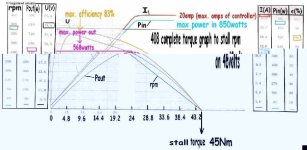ElectricEd
100 W
I have previously worked as an engineering fitter and turner over 10 years. IMHO opinion I think I know a little more about transmission backlash than the average joe. I have recently been involved with industrial robots where the elimination of backlash is critical.Lucky_Hoodlum: <edited with acknowledgement to mud2005>
not offering much factual information just puting down something
that has become very obvious you know little about.
put together a quality rc motor electric bike and do some real world comparisons with your hub motor bike, or all you will have are opinions.
They are not just opinions but real world experience. My brother's bike has a separate chain driving the rear wheel. As there is no freewheel, there is a large transmission backlash when going into regen. As I mentioned earlier regarding huskydave's proposed setup, if he is driving the bicycle chain he is driving the freewheeling cluster so backlash is not a problem. It's probably a universal law of engineering somewhere, but backlash doesn't occur with a freewheel because there is nothing to load up against.
Let's get it clear here, I have all along just explained my preferences and pointed out what I thought were the factors that made me choose one way or the other.
1/ I like a smooth transition between drive and regen. It is not possible for a simple gear system to do this. Ask any drivetrain engineer.
2/ The only part to wear out on a hub motor are the bearings. Not so with a chain drivetrain. You have chain stretch and shark-toothing sprocket wear. If using a derailleur system, the chain will start to jump with the extra load that a motor places on it after it has worn and stretched a bit. You'd have to be a fair weather rider to make it last much longer. The better Shimano clusters have hard chrome facing, but once you get through this with the silicon grit paste that comes from the road surface in wet weather, they don't last much longer than the cheapies. Using hub gears is a completely different matter. They are much more forgiving with chain stretch due to the more robust sprocket.
3/ When younger and a lot fitter and commuting 20Km each way through Winter, it'd take about 6 weeks for the chain to stretch. At 8 weeks the chain would start to jump. I'd need to get a new cluster and chain. I found that alternating 2 chains with one cluster I could extend the life of the drivetrain a bit. Maybe we have tougher silicon over here :wink: , but noting Toshi's and zoot kat's experiences with ice and salt, I reckon that would make up for any difference in grit composition.
4/ I like regen. If Jason says that I may only get 10%, I'll be happy with that. An extra 3 or 4 kilometres on my range may make the difference between smiles and that long walk home. Not to mention that it also closes the gap between the efficiencies of the 2 motor types.
5/ recumpents 1000 miles may not be enough to get a good feel for wear if he only rides in fair weather. It takes me a bit less than 6 weeks to do that much. Since taking up ebiking, I have done nearly 2800 miles (4500Km) using the same chain and cluster. I obviously don't pedal as hard as I used to. I also try to avoid heavy downpours with a fully charged 48V LiFePO4 just at my butt. Going by my experience, if you are riding in all weathers and driving a bike's chain drive with a motor that will be delivering at least twice the power that a human can deliver, the drivetrain must wear more quickly.
6/ And finally, fewer parts to go wrong.



